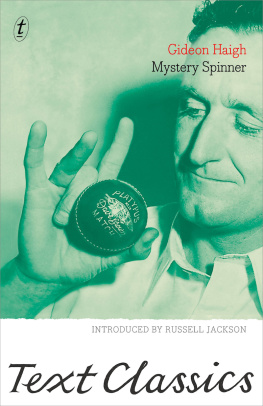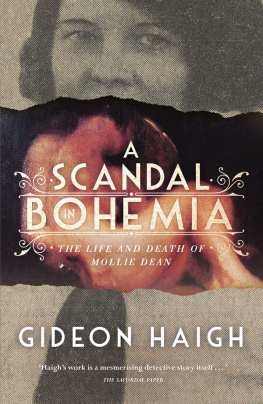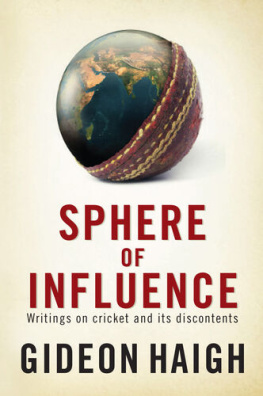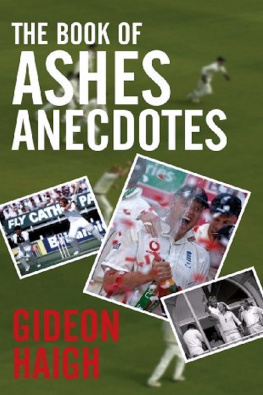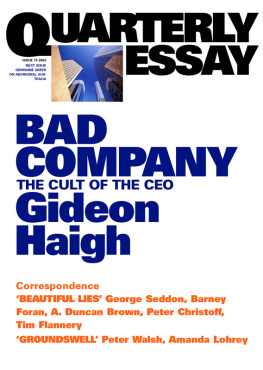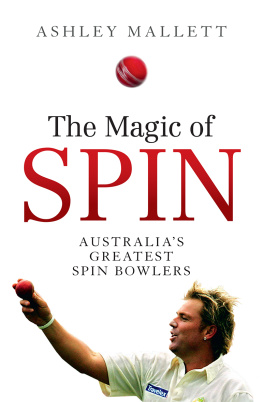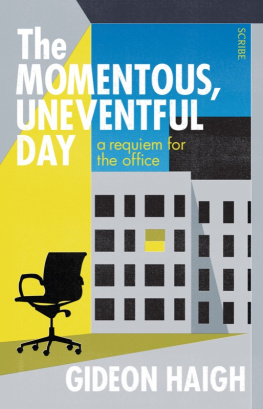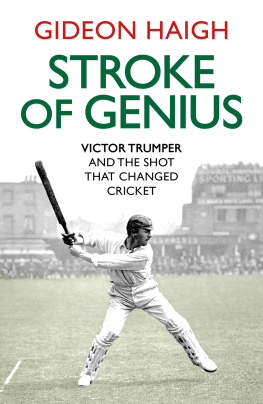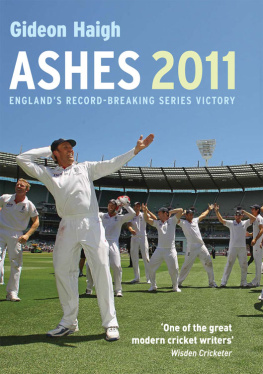Mystery Spinner: Text Classics
By Gideon Haigh
Introduced by Russell Jackson
No one replicated Jacks methods with anything like his success...For sheer originality, scarcely anyone in crickets history comes even close.
In 1950 tall, shy, shambling thirty-something Jack Iverson burst forth from obscurity in suburban Melbourne, bowled like no man before and became an international sensationthen exited from view almost as swiftly. Two decades later he died, near forgotten, in tragic circumstances. In the enthralling Mystery Spinner one of the worlds best cricket writers goes in search of an enigma: an ordinary man in whom lurked the extraordinary.
Sympathetic yet rigorous...Wonderful writing...A classic. Sunday Times
The visionary Diana Gribble founded Text in 1990. She wanted to create an independent publishing house that would find books to enlighten, challenge and entertain us. In keeping with this vision, Text Classics are books by our most loved writers who tell our stories.
Text Classics
GIDEON HAIGH was born in London in 1965 and raised in Geelong, Victoria. He was a staff journalist at Melbournes Age newspaper from 1984 until 1992, then worked for the Independent Monthly and the Australian. His freelance journalism-on business, cricket, the business of cricket, and much else besides-has appeared in more than one hundred newspapers and magazines.
In addition to editing a number of collections, Haigh has written on average a book a year for the past thirty years, beginning with The Battle for BHP in 1987. Mystery Spinner (1999)winner of the Australian Cricket Societys Jack Pollard Literary Award and the English Cricket Societys Book of the Year awardalong with The Big Ship (2001) and The Vincibles (2002), cemented his international reputation as one of the finest writers on cricket; a decade later, On Warne won a host of prizes.
Among his most notable works on subjects other than cricket are Asbestos House (2006), The Racket (2008), The Office (2012) and Certain Admissions (2015). His most recent book is the acclaimed Stroke of Genius (2016).
Gideon Haigh lives in Melbourne with his wife, Charlotte, and daughter, Cecilia. A keen amateur cricketer since childhood, he is a life member of the South Yarra Cricket Club.
RUSSELL JACKSON is a writer, editor and publisher from Melbourne. He is a former sportswriter and deputy editor of Guardian Australia. His essays and journalism have also appeared in books and magazines.
ALSO BY GIDEON HAIGH
The Battle for BHP
The Cricket War: The Inside Story of Kerry Packers World Series Cricket
The Border Years
One Summer, Every Summer: An Ashes Journal
The Summer Game: Australian Cricket in the 1950s and 1960s
One of a Kind: The Story of Bankers Trust Australia 1969-1999
The Big Ship: Warwick Armstrong and the Making of Modern Cricket
The Vincibles: A Suburban Cricket Season
The Uncyclopedia
Bad Company: The Strange Cult of the CEO
The Tencyclopedia
Game for Anything: Writings on Cricket
A Fair Field and No Favour: The Ashes of 2005
Asbestos House: The Secret History of James Hardie Industries
Silent Revolutions: Writings on Cricket History
All Out: The Ashes 2006-07
The Green and Golden Age: Writings on Australian Cricket Today
Inside Story: Unlocking Australian Crickets Archives (with David Frith)
The Racket: How Abortion Became Legal in Australia
Inside Out: Writings on Cricket Culture
Good Enough: The Ashes 2009
Sphere of Influence: Writings on Cricket and its Discontents
Out of the Running: The Ashes 2010-11
The Office: A Hardworking History
On Warne
The Deserted Newsroom
End of the Road?
Uncertain Corridors: Writings on Modern Cricket
Ashes to Ashes: How Australia Came Back and England Came Unstuck, 2013-14
Certain Admissions: A Beach, A Body and a Lifetime of Secrets
Stroke of Genius: Victor Trumper and the Shot that Changed Cricket
The Quest for Iversonby Russell Jackson
THERE was a time when the spin bowler existed as a kind of artist figure within the ranks of cricketers. The Manchester Guardian cricket writer and music critic Sir Neville Cardus wrote that Australias first truly great Test spinner, the 1920s idol Arthur Mailey, was an artist in every part of his nature. He called Mailey the most fascinating cricketer hed known. Hed known plenty.
Mailey twirled his way to international renown not through private schooling, coaching clinics or cricket academies, but the mean streets of the inner-Sydney slum of Waterloo, and the esteemed painter J. S. Watkins art classes. When his playing days were done and hed turned his hand to journalism and cartooning, he was upbraided by Australias nationalistic team manager, William Kelly, for revealing his dastardly tricks to the England leg-spinner Ian Peebles. Please understand that slow bowling is an art, Mailey deadpanned in response, and art is international.
The origin story of Maileys destructive googly-a delivery dreamily launched after a few playful steps, during which the ball was mischievously hidden behind his back-is worth recounting for the chain of events it set off. In his delightful 1958 memoir, 10 for 66 and All That, Mailey claims it started after one of his regular trips to the Art Gallery of New South Wales. Joining an impromptu cricket game at a nearby park, Mailey encountered an anonymous benefactor who showed him the Englishman Bernard Bosanquets wrong un.
Armed with this new weapon, Mailey rushed home like somebody who had found a nugget of gold. Almost a century later, no Australian bowler has bettered his figures of 9 for 121 in an innings to raze Englands Ashes tourists of 1920-21 in the fourth Test, in Melbourne.
Mailey passed on the secret of his bosie to considerable effect. The Kiwi-born spin machine Clarrie Grimmett begged him to explain it on an Australia XIs tour of New Zealand in 1914. Grimmett pooled his intel with Bill Tiger OReilly, who in turn primed Richie Benaud. Within a few decades these secrets linked each member of Australian spin royalty.
There followed barren years in which many feared the art of spin bowling might be dead-bludgeoned out of existence by the exhilarating and unsubtle pace barrage underpinning the West Indies dominance of the 1970s and 80s. Terry Jenner, an attacking leggie and puckish character, managed only nine Tests during the wild and woolly Chappell era. After some stumbles in life he found purpose again coaching a new generation of spinners, and lasting fame thanks to the extraordinary feats of a certain star pupil: Shane Keith Warne. The small matter of 708 Test wickets later, spin bowling was back.
Mystery Spinner, Gideon Haighs brilliant biography of Jack Iversongoogly bowlings shooting star of the early 1950swas first published in 1999 It arrived at the apex of Warne-mania. In Australia, that peroxide-fuelled tornado was blowing away every wincing memory of spins lean times: workaday lefty Ray Bright, bespectacled Murray Bennett, grandfatherly Bob Dutchy Holland, each toiling in the face of batting onslaughts and public indifference to their arcane craft. Whoosh. Fizz. Smack.
The most obvious and lucrative book for the best young cricket writer in Australia to write in the late 1990s would, of course, have been an appraisal of the messianic Warne. God knows everyone else was at it. Neither predictable nor commercially inclined, Haigh instead plumped for Iversontwenty-six years dead, decidedly non-blond and largely forgotten.

